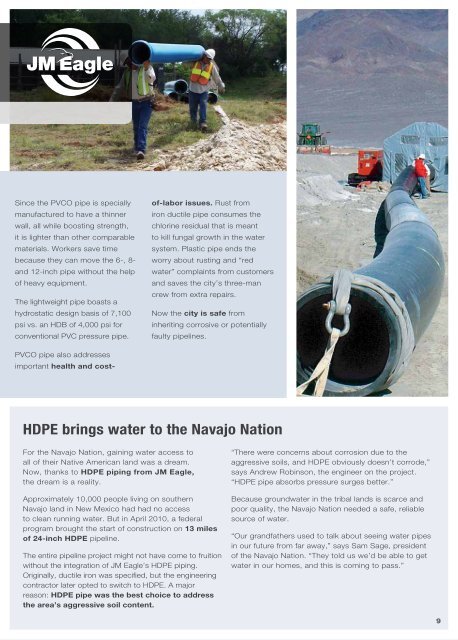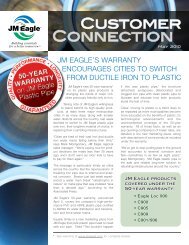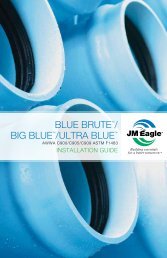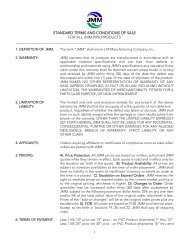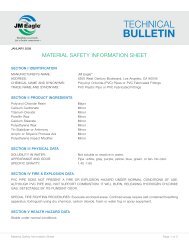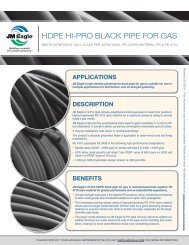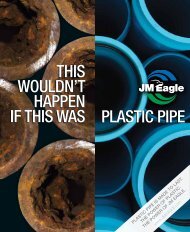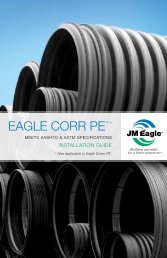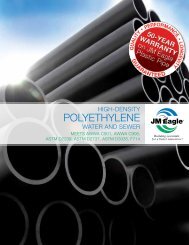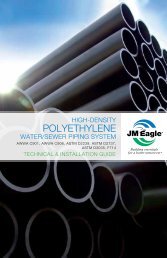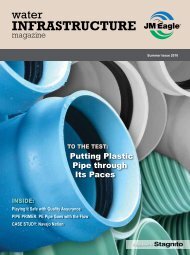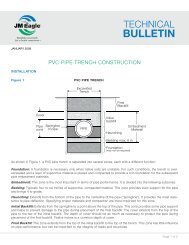JM Eagle Corporate Brochure (PDF)
JM Eagle Corporate Brochure (PDF)
JM Eagle Corporate Brochure (PDF)
Create successful ePaper yourself
Turn your PDF publications into a flip-book with our unique Google optimized e-Paper software.
Since the PVCO pipe is specially<br />
manufactured to have a thinner<br />
wall, all while boosting strength,<br />
it is lighter than other comparable<br />
materials. Workers save time<br />
because they can move the 6-, 8-<br />
and 12-inch pipe without the help<br />
of heavy equipment.<br />
The lightweight pipe boasts a<br />
hydrostatic design basis of 7,100<br />
psi vs. an HDB of 4,000 psi for<br />
conventional PVC pressure pipe.<br />
PVCO pipe also addresses<br />
important health and costof-labor<br />
issues. Rust from<br />
iron ductile pipe consumes the<br />
chlorine residual that is meant<br />
to kill fungal growth in the water<br />
system. Plastic pipe ends the<br />
worry about rusting and “red<br />
water” complaints from customers<br />
and saves the city’s three-man<br />
crew from extra repairs.<br />
Now the city is safe from<br />
inheriting corrosive or potentially<br />
faulty pipelines.<br />
HDPE brings water to the Navajo Nation<br />
For the Navajo Nation, gaining water access to<br />
all of their Native American land was a dream.<br />
Now, thanks to HDPE piping from <strong>JM</strong> <strong>Eagle</strong>,<br />
the dream is a reality.<br />
Approximately 10,000 people living on southern<br />
Navajo land in New Mexico had had no access<br />
to clean running water. But in April 2010, a federal<br />
program brought the start of construction on 13 miles<br />
of 24-inch HDPE pipeline.<br />
The entire pipeline project might not have come to fruition<br />
without the integration of <strong>JM</strong> <strong>Eagle</strong>’s HDPE piping.<br />
Originally, ductile iron was specified, but the engineering<br />
contractor later opted to switch to HDPE. A major<br />
reason: HDPE pipe was the best choice to address<br />
the area’s aggressive soil content.<br />
“There were concerns about corrosion due to the<br />
aggressive soils, and HDPE obviously doesn’t corrode,”<br />
says Andrew Robinson, the engineer on the project.<br />
“HDPE pipe absorbs pressure surges better.”<br />
Because groundwater in the tribal lands is scarce and<br />
poor quality, the Navajo Nation needed a safe, reliable<br />
source of water.<br />
“Our grandfathers used to talk about seeing water pipes<br />
in our future from far away,” says Sam Sage, president<br />
of the Navajo Nation. “They told us we’d be able to get<br />
water in our homes, and this is coming to pass.”<br />
9


